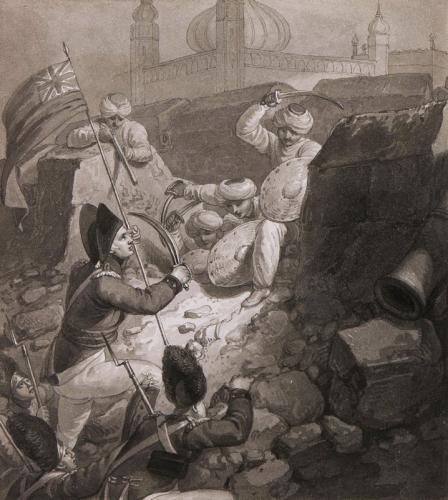The Storming of Seringapatam
Guide Price: £650
Make An OfferPen and sepia wash; 5 ½ by 4 ¾ in; 13.5 x 12 cm; framed
Provenance: Abbott & Holder, Winter Exhibition, 1988; private collection, England
The ancient fortress city of Seringapatam (now called Srirangapatna or Srirangapatnam) was the capital for the Muslim rulers of the kingdom of Mysore, Haidar Ali (c.1722 – 1782) and his eldest son, Tipu Sultan (1753 -1799). It was located on an island in the Cauvery River and derived its name from the ancient Hindu temple of Sri Ranganatha Swami which is located at the western end of the the island. The city became the site of two of the most famous sieges of the Anglo-Mysore Wars in 1792 and 1799.
The assault against the island fortress in 1799 was a military operation involving two British armies and East India Company forces totalling approximately 40,000 soldiers, including contingents of troops sent by the Nizam of Hyderabad. The campaign strategy was based upon the need to approach the city simultaneously from the east – the Grand Army, under the command of General George Harris from Madras, and from the west – the Bombay Army, under the command of Lieutenant-General James Stuart from the Malabar coast.
This campaign culminated in the storming and capture of the fortress city on 4th May 1799. Tipu Sultan, the ‘Tiger of Mysore’ led a stout defence that saw nearly 10,000 Mysoreans killed, including Tipu himself who may have been betrayed by one of his own confidants. His body was dragged from beneath a pile of dead by the city’s northern gate, suggesting that he had continued fighting to the very end. Following his death, Mysore was partitioned and the rump of the state given to a British client ruler. Tipu was one of the most formidable Indian opponents the British ever faced and his death removed one of the chief obsticles to their conquest of the subcontinent.
The subject of Seringapatam was one that inspired an outpouring of visual imagery in Britain. Whilst imperial in tone many depict the resisting forces of Mysoreans as heroic adversaries. Craig depicts a moment when the defences of the fortress have been breached and both forces fearlessly engage.
William Marshall Craig began exhibiting at the Royal Academy in 1788, and moved to London shortly afterwards. He began working as a miniature and portrait painter, varying this with occasional rustic figures, domestic scenes and landscapes in watercolours. Notably he was drawing master to Princess Charlotte of Wales, miniature painter to the Duke and Duchess of York, and painter in watercolours to Queen Charlotte.



